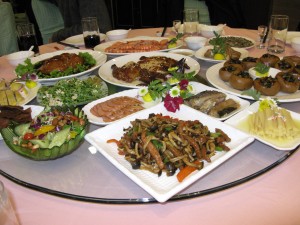
Food for the Lauriat
A Chinese banquet cannot be called a lauriat unless it features eight to ten dishes – at the very least, that is. Several appetizers are served at the beginning of the meal; although these are counted as one menu item, this opening salvo can include more than a few delicacies. In Redcook’s Anatomy of a Chinese Banquet Menu, Kian Lam Kho shares his family table’s appetizers for a New Year lauriat: smoked ham hock, jellyfish salad, drunken chicken, shrimp salad in mustard mayonnaise, and century eggs.
This is already rich selection is followed by braised sea cucumber, crispy fried chicken in garlic sauce, eight treasures winter melon soup, red cooked meat with steamed buns, kung pao frogs, mustard greens with crabmeat, steamed sea bass, Chinese sausage fried rice, and deep fried red bean paste in meringue for dessert.
When the lauriat is held to celebrate traditional holidays, there are certain foods are considered a “must” in the menu. Kian Lam Kho puts it this way:
“One of the most important considerations in my menu design was the inclusion of traditional dishes for Chinese New Year. Although there are huge variations regionally, the fish course unquestionably is a must. This tradition was based on a Chinese proverb celebrating abundance of surplus every year (年年有餘). The character for surplus is pronounced “yu” which happens to be a homophone for fish. So having fish on New Year’s Eve is equivalent to having surplus at the end of the year. Other Chinese New Year food traditions include dumplings in Northern China, and hair like seaweed from Southern China…”
In his article, Kho makes it clear that apart from the customary menu items in the lauriat, the meal must also contain a wide variety of meats, textures, and flavors. “It was also important for me to balance the type of meat and vegetable dishes in a Chinese banquet. The commonly accepted wisdom is to include poultry, pork or beef, seafood, vegetable and starch (rice or noodle) dishes. I chose one dish from each of the categories plus exotic meat like frogs…”
Etiquette and Seating Arrangements
There is more to a lauriat than serving an enormous amount of food. Although the niceties of this celebratory meal have somehow become watered down in ultra-modern, multi-cultural settings, certain rules of decorum are still adhered to.
In China Highlight’s Seating Arrangements for a Chinese Banguet, Annie Wu says, “The seat of honor, reserved for the master of the banquet or the guest with highest status, is the one in the center facing east or facing the entrance. Those of higher position sit closer to the master of the banquet. The guests of lowest position sit furthest from the seat of honor. When a family holds a banquet, the seat of honor is for the guest with the highest status and the head of the house takes the least prominent seat…
“If round tables are used, the seat facing the entrance is the seat of honor. The seats on the left hand side of the seat of honor are second, fourth, sixth, etc in importance, while those on the right are third, fifth, seventh and so on in importance, until they join together…”
Drinks during the Lauriat
Wine may be served during a lauriat, but unlike Western banquets where wines are served to enhance the food (or vice versa), wines served during the Chinese banquet are there for toasting. The first toast, made by the host, is directed to the guest of honor. Subsequent toasts are made to the honored guests seated on either side of the host. With every toast, a guest consumes all the wine in his or her glass, so if numerous toasts are made, people can end up drinking more than they thought they would.
In Scene Asia – Food and Drink Section’s Drinking at Chinese Business Banquets, Eddie Yatming Lam writes: “The ritual and rhythm of toasting is designed to build up an atmosphere of mutual respect between host and guest. Drinks serve as a vital tool for good guanxi, or relationships, and toasts can be made frequently throughout the banquet until the very end…”
The Chinese banquet offers the guest a lot of food and possibly a lot of wine. Unlike Western dinners, however, the focus of the banquet is honoring the guest or the celebrant. Many a business deal is closed after a banquet, and many diplomatic relationships are forged over a plate of braised crispy pigeon. Fortunately, although the lauriat is peppered with protocol, good food is part of the deal.


Speak Your Mind